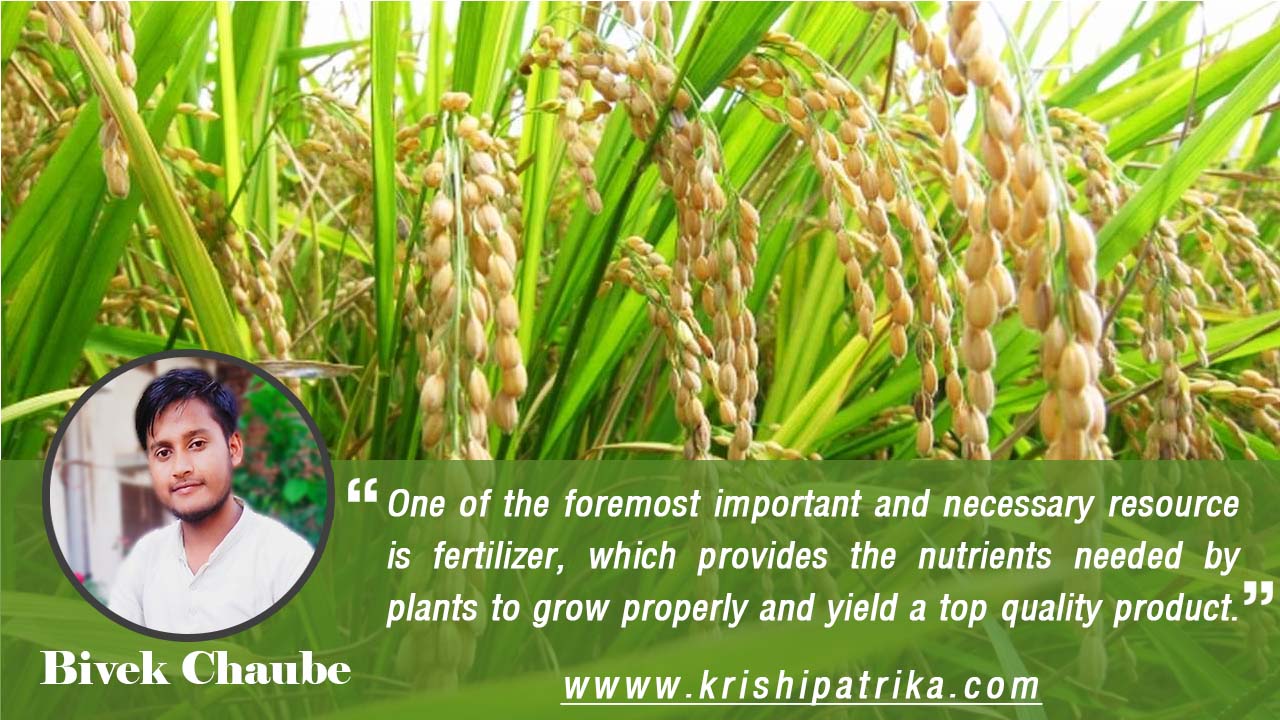
The successful production of crops requires a farmer to form maximum use of all available resources. One of the foremost important and necessary resource is fertilizer, which provides the nutrients needed by plants to grow properly and yield a top quality product.
The most essential nutrients required for rice crops are macronutrients such as nitrogen (N), phosphorus (P), and potassium (K). Some other essential micronutrients required for good yield is Zinc (Zn) and Iron (Fe).
The amount of nutrients application should be done based on the fertility status of the field where cropping is to be done, for this soil testing is very important. The general recommendation of Fertilizer application for supply of NPK is 120kg of nitrogen (N) per hectare, 40kg of phosphorus (P) per hectare & 40 kg of potassium (K) per hectare.
Sources of Nutrients:
Inorganic source:
The best source for the supply of Nitrogen is Urea (46%N), phosphorus is DAP (18:46:0) and Potassium is MOP (60%K2O). Zinc is supplied through Zink Sulphate (Znso4) of 0.5% solution.
Organic source :
Azolla in association with blue-green alga Anabaena in rice crops can fix atmospheric nitrogen (N) into ammonia which can be utilized by rice plants when it is incorporated into the soil. Azolla contains from 2−5% N, 0.3−6.0% Potassium (K) (dry weight). Azolla is often utilized in two ways:
1) As green manure incorporated before transplanting, and
2) As an intercrop incorporated after transplanting.
In each case, about 500 kg (fresh weight) per ha is introduced into standing water in the rice field.
Sesbania; A legume commonly used as a manure crop to feature nitrogen and organic content to the soil. Sesbania can produce up to 80−100 kg N/ha. The organic matter and nitrogen produced by sesbania help to improve the soil and subsequent crop growth. Sesbania is planted before or after rice crop when the land is vacant and then is incorporated before land preparation.
Organic materials and manures come from plant or animal wastes or by-products like cattle or poultry manure, composted rice straw or other crop residues, sewage sludge, oil cakes, green manures, and legume clippings can boost up the soil fertility and make more availability of micronutrients.
Time and method of Application of Inorganic Fertilizer;
Phosphorus and potash can be applied at the time of land preparation for transplanting. DAP or mixed fertilizer containing NPK can also be incorporated at field preparation time. Nitrogen is applied in 2-3 split doses after transplanting.
Nitrogen
Nitrogen; The most limiting element in almost all soils. Thus, the proper application of N-fertilizers is significant to enhance crop growth and grain yields, especially in intensive agricultural systems. Insufficient and/or inappropriate fertilizer N management is often detrimental to crops and therefore the environment. To increase Nitrogen use efficiency Nitrogen Fertilizer is applied in split doses. Basal dose of Nitrogen Fertilizer should be avoided.

Fig:- LCC (Leaf colour Chart)
Leaf colour and crop appearance indicate the plant N status and help determine the necessity for N fertilizer application. See Fact Sheets on a) Leaf Chart (LCC) for crop need-based N management, and b) Nitrogen split applications for growth stage-based N management using the LCC.
The efficiency of nitrogen (N) fertilizer is often improved by monitoring leaf colour at 7- to 10-day intervals with the leaf colour chart (LCC) and only applying N fertilizer as needed by the crop. The critical stages of Nitrogen application are tillering, panicle initiation, and Flowering. Nitrogen Fertilizer is top-dressed but before irrigation.
Phosphorus
Phosphorous (P) is an essential plant nutrient important for root development, tillering, early flowering, and ripening. It is mobile within the plant, but not within the soil.
Incorporate all fertilizer P before the last soil puddling before transplanting or topdress all P within 10−15 days after direct seeding.
Potassium
Potassium (K) is an important plant nutrient that improves root growth and plant vigor helps prevent lodging and enhances crop resistance to pests and diseases. Potassium is mobile within the plant and quite mobile within the soil.
Incorporate all fertilizer K before the last soil puddling before transplanting or topdress all K within 10−15 days after direct seeding.
Zinc
Zinc deficiency causes Khaira disease of rice. Zinc helps in the production of chlorophyll pigment and helps in photosynthesis. The commonly used Zn fertilizers are soluble zinc sulfate (23−36% Zn), soluble zinc chloride (48−50% Zn), and insoluble zinc oxide (60−80% Zn). This should be applied within 30 days of transplantation by foliar application. Over flooding in the rice field is a major cause of zinc deficiency so proper drainage should be provided.
Fertilizers account for one-third or more of crop yields. Inadequate fertility starves plants. Excess fertility is wasted and can cause physical injury and death to plants as well as pollution to the environment. It is necessary therefore to provide plants with precise and balanced amounts of nutrients needed for its optimal growth and development but avoiding excessive amounts that will be eventually lost to the environment.
The inefficient use of fertilizers is generally a cause for concern. Issues such as nitrate leaching, eutrophication, and consumption of non-renewable resources originate with fertilizer use.
So a balanced application of Fertilizer creates a favorable environment for the rice crop to boost up the yield.
Writer : Bivek Chaube









